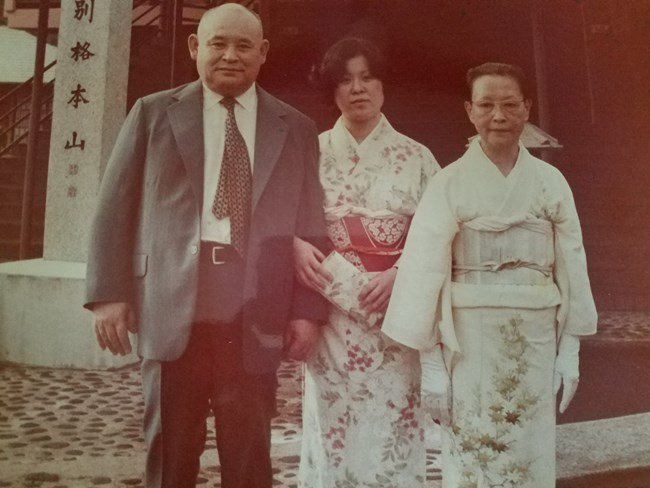Part of a series of articles titled Women's History in the Pacific West - Pacific Islands Collection.
Previous: Cecilia “Chilang” Cruz Bamba
Next: Haruko Takahashi
Article

NPS photo.
Kiyome Hirai Tsuda was a kibei, a US citizen educated in Japan, who exemplified the deep connections between Hawai‘i and Japan before World War II. When war broke out, her frequent trips to Japan and status as a religious leader made her a target of the US government. She spent most of the war imprisoned in the Honouliuli Internment Camp, alongside Japanese Americans suspected of disloyalty and prisoners of war.1 Throughout her imprisonment, she sustained a religious life and network, resuming her position as a temple leader after her release.
Kiyome Hirai was born in Kona, Hawai‘i in 1910.2 The second eldest of six children, she split her childhood between Hawai‘i and Kumamoto, Japan. She returned to Hawai‘i in 1929 and married Leonard Taizo Tsuda two years later, though the couple divorced in 1940. After the breakup of her marriage, Kiyome Tsuda found solace in the monastic life and strict routine of Buddhist training. Following in the footsteps of her mother, Priestess Nyofu Hirai, Tsuda trained at the Todaiji Temple in Nara, Japan. She was ordained as a priestess in 1941, and returned to O‘ahu as a missionary, ministering to Japanese migrants and their families.3 In Hawai‘i, Tsuda’s temple sustained forty to fifty loyal members drawn to her healing powers and religious syncretism, hallmarks of the Japanese New Religions.4 The New Religions, a growing set of practices and groups that blended elements of Buddhism, Shinto, Christianity, Confucianism, and other philosophies, were often headed by women and charismatic leaders, as well as people with healing abilities like Tsuda.5
Tsuda’s familial ties to Japan and position as a religious leader made her a target of the US government after the attack on Pearl Harbor on December 7, 1941. Arrested on June 18, 1942, Tsuda was held at the Sand Island Detention Camp, just off the coast from Honolulu.6 At a hearing into her supposed guilt, the review board cited her prayer rituals and home shrine as evidence of her failure to properly assimilate to “American” culture and her years of education in Japan as justifying continued imprisonment.7 In addition, Tsuda’s possession of “supernatural powers” and accusations that she prayed for a Japanese victory (despite her disavowal of such action) led US officials to view her as a security threat.8 Her accusers employed a combination of common charges of disloyalty as well as gendered accusations that she was “fanatical” and inappropriately influential over men.9
In March 1943, she was transferred to Honouliuli Internment Camp.10 The records indicate Tsuda was one of only eight women and nine known Buddhist or Shinto priests to be incarcerated among the approximately 364 civilians imprisoned at Honouliuli.11 Most Japanese religious leaders who were arrested in Hawai‘i shortly after the Pearl Harbor attack were eventually sent to concentration camps on the mainland. In the Honouliuli Interment Camp, Tsuda lived with the incarcerated civilians in a separate women’s area. She violated camp rules on multiple occasions by sneaking letters out of the camp to communicate with her temple members and by talking to her male followers “across the fence” in the sex-segregated camp. She also continued dedicated fasting and prayer, including prayers for her followers’ sons who were part of the US fighting force in Italy.12
After the war, going by the name Tatsusho Hirai, she returned to religious leadership. She funded the construction of a new temple in Honolulu, called “Bekka-kku Honzan Todaiji of Hawaii,” which opened in 1956 as an affiliate of the main temple in Nara.13 At 77 years old, she died on July 9, 1987 in Honolulu.14 Her religious legacy lives on in the now independent temple, Todaiji Hawaii Bekkaku Honzan, which serves its members to the present day.15
Part of a series of articles titled Women's History in the Pacific West - Pacific Islands Collection.
Previous: Cecilia “Chilang” Cruz Bamba
Next: Haruko Takahashi
Last updated: February 23, 2022